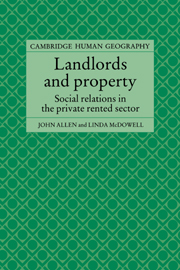Book contents
- Frontmatter
- Contents
- List of figures and tables
- Preface
- 1 Introduction
- 2 Private landlords: the anatomy of uneven decline
- 3 The structure of private landlordism
- 4 Research design and methods
- 5 Landlords in profile: an intensive survey
- 6 Landlords in the inner city: an extensive survey
- 7 Political ideologies and private rental policies
- Policy postscript
- Appendix 1 Selecting the landlord sample from housing waiting list records
- Appendix 2 Who was rehoused?
- References
- Index
3 - The structure of private landlordism
Published online by Cambridge University Press: 17 September 2009
- Frontmatter
- Contents
- List of figures and tables
- Preface
- 1 Introduction
- 2 Private landlords: the anatomy of uneven decline
- 3 The structure of private landlordism
- 4 Research design and methods
- 5 Landlords in profile: an intensive survey
- 6 Landlords in the inner city: an extensive survey
- 7 Political ideologies and private rental policies
- Policy postscript
- Appendix 1 Selecting the landlord sample from housing waiting list records
- Appendix 2 Who was rehoused?
- References
- Index
Summary
The previous chapter traced the structured but uneven decline of the private rented housing sector and argued that three processes, disinvestment, investment and informalisation, were significant in accounting for the changing pattern of private renting. In this chapter we turn our attention from the processes themselves to the agents who are involved in these processes. It is clear that private landlords are a diverse and heterogeneous social group and much of the literature on landlords and the rented housing market has attempted to reveal the diversity of their actions in the market place: the extent to which tenancies have been converted from unfurnished to furnished, the lack of amenities in rented housing, the number of improved properties, the extent of sales to owner-occupation, and so forth. Such studies, as noted in the previous chapter, have indeed contributed to our understanding of the changes that have occurred in the rented housing market, but they have often left us with little detailed knowledge of who is actually carrying out these actions or why they were undertaken. There is a methodological gap between the exhaustive detail with which landlords' activities are plotted and the analytical skills used to classify the nature and characteristics of different types of landlords.
- Type
- Chapter
- Information
- Landlords and PropertySocial Relations in the Private Rented Sector, pp. 40 - 58Publisher: Cambridge University PressPrint publication year: 1989



